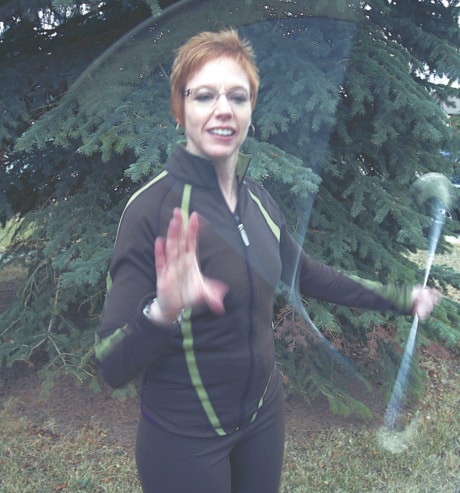There’s something mesmerizing about baton twirling.
It’s impossible to look away when a baton is tossed high and spinning fast, before it falls to where a baton twirler snatches it out of the air.
“I saw a baton twirler in a parade,” said Wendy Cruickshank, 45, who became fascinated with twirling when she was seven and lived in Medicine Hat.
“I just wanted to make it move. I spent the summer taking sticks off branches and making my own baton until my parents bought me a plastic baton from a toy store.”
She twirled competitively to an advanced level until her late teens. When she moved to Red Deer, she became a featured baton twirler with the Red Deer Royals.
Cruickshank, who was a baton coach for 20 years in Red Deer, Blackfalds and Lacombe, has been an adjudicator for 25 years, judging all levels including representing Canada at World Baton Twirling Championship and the International Cup.
Even though she now restricts her activity to judging, as well as being a teacher of judges, Cruickshank is still busy. Between February and May, she will have adjudicated at 10 competitions.
She smiled while talking about the “little darlings” with batons who captured her heart last weekend in Regina.
“It’s as much fun to see the excitement on their faces and evaluate them as it is to evaluate at world championships and see the very best in the world.”
Right now with no active baton twirler coaches in Red Deer, about 100 local twirlers practise in Calgary.
“The sport is dependent upon having qualified coaches whereas in other sports, such as soccer, you can get a volunteer mom or dad to coach.”
Between 200 and 300 Albertans compete with the baton.
“Currently the country that provides the highest level of baton twirlers is Japan. They have baton in school. They have over a million twirlers in that country.”
In Canada, where it’s not taught in school, twirling is on the decline.
“We have found our numbers decreasing recently because of the options for girls. Generally, we competed only with gymnastics, dance, skating. Those were the big three. Now girls play soccer, girls play hockey, girls play ringette.”
Canadian twirling has also become more of a sport rather than entertainment in parades, Cruickshank said.
“I believe we’re losing exposure by not going in parades because everyone else does not know we’re here.”
“In the States, there isn’t a basketball game, a football game that doesn’t have a group of twirlers performing at it, whether it’s at high school or university.”
A number of universities in the United States offer scholarships for baton twirlers, which some Alberta twirlers have won, she said.
Elite twirlers practise 30 to 35 hours a week, including dance and gymnastic training. They compete in freestyle, pairs and team competitions and twirl one, two or three batons at once.
Competition is open to athletes age 12 and up.
It requires hand-eye co-ordination, timing, stamina, flexibility and creativity through movement, music and costume.
Cruickshank said twirling is a motor skill that anyone can develop.
“If had a baton here, I could have you twirling in five minutes. And the first thing you’ll want to do is throw your baton up in the air.”
szielinski@www.reddeeradvocate.com
